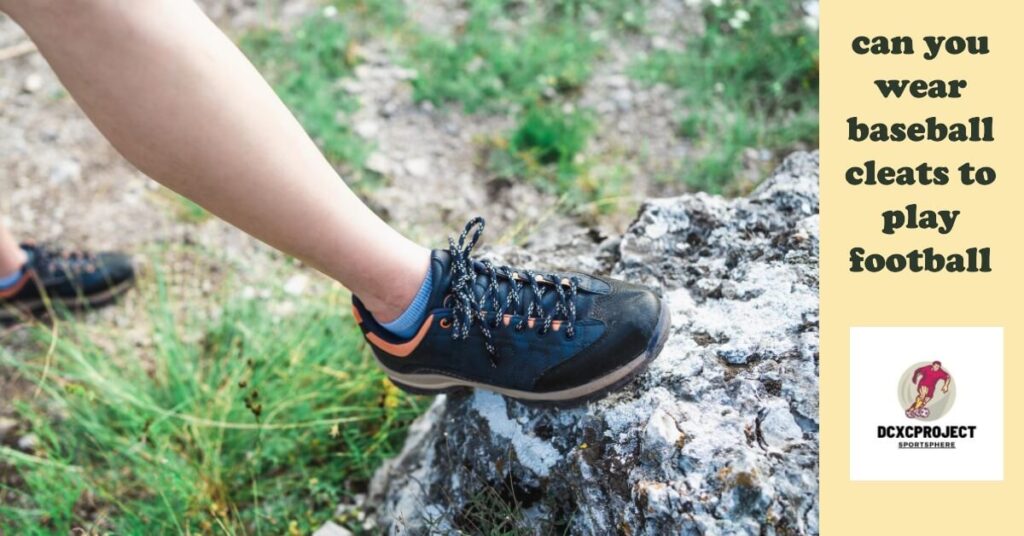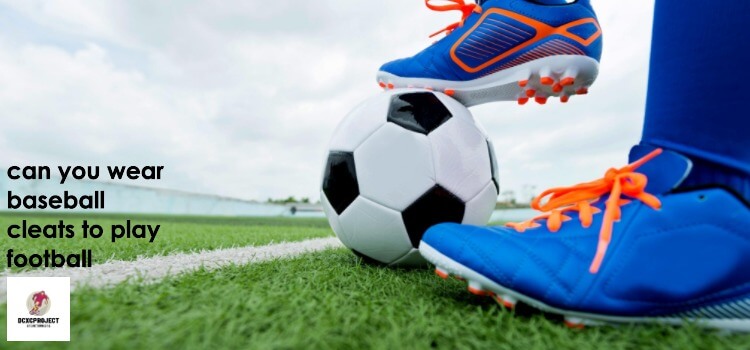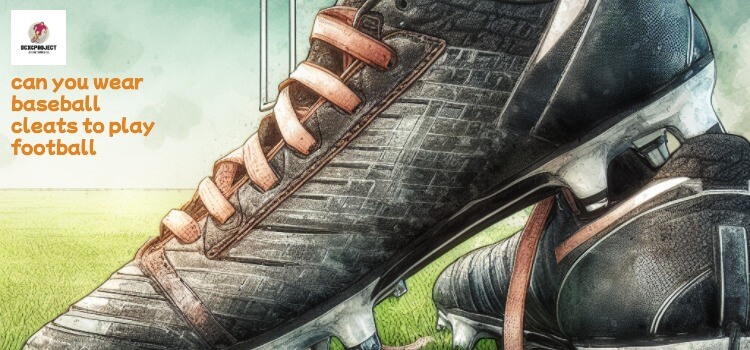Can you wear baseball cleats to play football? is a question that often crosses my mind as a passionate sports enthusiast, always eager to explore the versatility of athletic gear.
Selecting the right footwear is crucial for any sport, as it can substantially affect your performance and safety. Specifically, when it comes to football, players need to consider the unique demands of the sport which include agility, speed, and safety.
While both baseball and football cleats may seem similar upon first glance, the design differences are significant and serve specific purposes for their respective sports. Football cleats are optimized for lateral movement and traction without a front toe cleat, which could pose a risk during tackles or pile-ups. By choosing the proper cleats, athletes not only uphold the rules of the game but also minimize their risk of injury while maximizing their ability to perform on the field.
Understanding The Difference Between Baseball And Football Cleats
When it comes to playing sports, the right footwear is imperative for both performance and safety. Baseball and football are two sports that, while sharing similarities, have distinct requirements for their respective cleats. Understanding these differences can save athletes from discomfort and injuries, as well as improve their game. Let’s delve into the construction and design variations, as well as the traction needs specific to each sport.
Construction And Design Variations
Baseball and football cleats are crafted with specific intentions in mind, tailored to the movements and needs of each sport. The design variations are crucial, influencing factors like agility, speed, and stability.
- Baseball cleats often feature a toe cleat, which is a spike located at the front of the shoe. This toe cleat aids players in digging into the dirt for better acceleration and traction during batting and fielding.
- In contrast, football cleats typically lack a front toe cleat to prevent injury and provide more underfoot protection, considering the high-contact nature of football.
- Moreover, football cleats usually have a higher cut, designed to provide additional ankle support due to the lateral movements and tackles experienced in the game.
- Baseball cleats may come in low-top or mid-top design, offering flexibility for quick directional changes without the concern of tackling.
| Cleat Type | Design Feature | Benefit |
|---|---|---|
| Baseball | Toe cleat | Improved traction for batting and fielding |
| Football | No toe cleat | Safe, with added underfoot protection |
| Football | Higher cut | Increased ankle support |
| Baseball | Lower cut | Enhanced flexibility for running and quick turns |
Traction Requirements For Each Sport
The traction beneath an athlete’s foot is essential in ensuring they can make the necessary movements in their sport without slipping. Both baseball and football cleats provide traction, but they are designed with the playing surface in mind.
- Baseball fields often consist of both grass and dirt areas. Cleats for baseball are designed to offer consistent traction across varying surfaces. The studs on baseball cleats are generally thinner to provide a grip on harder dirt surfaces while allowing for speed and maneuverability.
- Football players, on the other hand, require a different type of traction. The studs on football cleats are typically thicker and wider to handle the softer, more malleable grass fields and to offer optimal support during high-impact, abrupt direction changes. This difference can mean that wearing baseball cleats in football may not provide the necessary grip and could lead to slipping or injury.
Remember, selecting the right cleats is about more than just comfort. It’s about enhancing performance and ensuring the player’s safety by meeting the sport-specific demands.
Are Baseball Cleats Suitable For Football?
Cleats are an essential component of any sports uniform, designed to increase traction and performance on the field. When it comes to football, the right cleats can make a significant difference. Many athletes ponder whether they can extend the use of their baseball cleats onto the football turf. Let’s delve into the compatibility and implications of wearing baseball cleats in football.
Examining The Compatibility Of Baseball Cleats For Football
Baseball and football cleats might look similar, but they are crafted with different objectives in mind. Football cleats generally offer more ankle support to absorb the sudden turns and high-impact plays typical of the sport. On the other hand, baseball cleats have a toe cleat that helps when running the bases, a feature that football cleats lack as it could lead to injury during tackles.
Most football leagues have regulations regarding the type of cleats allowed. It’s essential to check with the league’s rules before stepping onto the field with cleats designed for another sport. Using non-conforming footwear could result in penalties or, worse, disqualification from play.
Impact Of Baseball Cleats On Performance And Safety In Football
The performance impact of wearing baseball cleats for football can be significant. Here are some critical considerations:
- Traction and Mobility: Football cleats are designed to provide optimal traction on different playing surfaces. Baseball cleats might not offer the same level of grip, potentially affecting an athlete’s mobility on the field.
- Ankle Support: The high-impact nature of football demands robust ankle support provided by football cleats. Baseball cleats might not offer adequate support, increasing the risk of sprains or other injuries.
- Toe Cleat Hazard: The toe cleats on baseball cleats, vital for baseball, can be dangerous in football. It can catch on the turf during quick directional changes, potentially causing knee or ankle injuries.
When it comes to safety, appropriate football cleats are essential. They protect against common field injuries and are specifically designed for dynamic actions in football. Wearing baseball cleats can increase the risk of trips, falls, and contact injuries.
Performance-wise, subpar cleats could hinder a player’s agility and responsiveness on the gridiron. Each sport’s cleats are tailored to the unique needs of the respective disciplines; thus, wearing baseball cleats could impede a football player’s abilities and their team’s overall performance.

Regulations And Guidelines
Regulations and Guidelines play a pivotal role in sports to ensure fair play, safety, and uniformity. This holds true for athletes contemplating whether to wear baseball cleats on the football field. Understanding the rules and restrictions set by football leagues alongside the safety considerations is critical for players who might be considering this equipment crossover. Non-compliance not only risks personal injury but can also lead to penalties or ejections from a game. It’s essential for players to adhere to the appropriate gear standards designed for their sport.
Rules And Restrictions Set By Football Leagues
Football leagues at various levels – from youth recreational leagues to professional stages – enforce specific equipment guidelines. These rules, often outlined in a league’s handbook, dictate the type of cleats permissible on the gridiron.
- Material Restrictions: Football cleats are usually made from rubber or plastic, providing grip without being overly sharp.
- Design Specifications: Cleats for football often feature smaller, more numerous studs for multi-directional movement.
- Length of Cleats: Regulations might specify maximum length to prevent injury and provide a level playing field.
Players must check their league’s requirements before stepping onto the field to avoid violating equipment standards, which can result in penalties for the individual or the team.
Safety Considerations And Potential Consequences Of Non-compliance
Wearing inappropriate footwear like baseball cleats in a football game poses a risk not just to the player, but also to teammates and opponents. Safety considerations are paramount, given the different design and build between baseball and football cleats.
| Safety Aspect | Baseball Cleats | Football Cleats |
|---|---|---|
| Stud Configuration | Designed for forward motion with a toe cleat. | Built for lateral movements without a toe cleat. |
| Traction and Stability | May provide too much grip at the toe, causing trips. | Evenly distributed support for various movements. |
| Injury Risk | Higher chance of knee and ankle injuries. | Lower risk when used on the appropriate turf. |
The potential consequences of not following cleat regulations can result in disciplinary action by the officials, including but not limited to:
- Player ejection from the game.
- Personal and team penalties.
- Suspensions for repeat offenses.
Moreover, non-compliance may lead to preventable injuries, therefore compromising player safety and team integrity.
Benefits And Drawbacks
Exploring the suitability of baseball cleats in football requires a nuanced look at both the benefits they offer and the potential drawbacks they might bring. Players looking to transition their gear between sports should weigh these factors carefully to ensure safety and performance on the field. This section will delve into the pros and cons of stepping onto the football field with baseball cleats, as well as examining the alternatives offered by specialized football footwear.
Pros And Cons Of Wearing Baseball Cleats For Football
| Pros | Cons |
|---|---|
|
|
Alternatives And Specialized Football Cleats
For athletes who switch between baseball and football, it’s important to consider specialized cleats designed specifically for the demands of each sport. Football cleats are engineered with features tailored to football’s unique maneuvers, such as:
- Enhanced Ankle Support: Higher cleat cuts designed to protect against frequent lateral movements and rapid direction changes in football.
- Position-Specific Variations: Cleats optimized for linemen, receivers, and other football positions, enhancing performance.
- Stud Variations: Different types and lengths of studs tailored for various field conditions, from turf to natural grass.
While it may be tempting to opt for a multi-sport approach with baseball cleats, investing in football-specific cleats could substantially improve safety and performance on the gridiron. Proper footwear can make a significant difference in an athlete’s game and can even prevent injuries.

Frequently Asked Questions For Can You Wear Baseball Cleats To Play Football
Are Baseball And Football Cleats The Same?
Baseball and football cleats are not the same. Football cleats typically have a toe stud, which is absent in baseball cleats. This difference helps with sports-specific movements and traction.
Can You Wear Any Cleats For Football?
No, specialized football cleats designed for the sport’s specific demands are required. Wearing improper cleats can lead to reduced performance and increased injury risk. Always choose cleats that conform to your league’s regulations.
Do NFL football Players Wear Cleats?
Yes, NFL players wear cleats to provide traction and support on the field during games and practices. Different positions may choose specific cleat styles for performance.
What’s The Difference Between Spikes And Cleats?
Spikes generally refer to athletic shoes with protruding metal or plastic points. Cleats are sports shoes with molded outsoles and studs or bars for traction on turf or grass.
Conclusion
Wrapping up, it’s clear that while baseball cleats may offer some versatility, they’re not ideal for football. Safety and performance are key on the field, and choosing the correct cleats is essential. Before lacing up for your next game, ensure you’ve got the right gear for the sport you’re playing.


Pingback: Can You Use Baseball Cleats for Football? Find Out the Best Footwear for Field Domination! - SportSphere